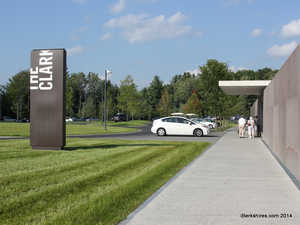Clark Art Exhibition On French Prints
WILLIAMSTOWN, Mass. — The Clark Art Institute presents an opportunity to explore steady opposition to the use of color in printmaking in nineteenth-century France.
"Hue & Cry: French Printmaking and the Debate over Colors" presents a array of French color prints from the Clark's works-on-paper collection, by artists including Pierre Bonnard, Mary Cassatt, Paul Cézanne, Jules Chéret, Maurice Denis, Camille Pissarro, Henri de Toulouse-Lautrec, and Édouard Vuillard.
The exhibition is on view Dec. 11, 2021 through March 6, 2022.
"Color prints are so widely accepted and beloved today that it's hard to understand the early opposition that these works received," said Olivier Meslay, Hardymon Director of the Clark. "While the controversy over color might seem quaint, this exhibition tells a fascinating story to explain the ways in which the art world confronted this change. Beyond the intriguing look at how public taste and critical opinion collided, we think that our visitors will find great delight in exploring these beautiful prints."
According to a press release, brightly colored prints and posters are synonymous with Paris in the 1890s—a period known as the Belle Époque (beautiful age). Yet their extraordinary popular appeal both then and now masks the fact that, for a very long time, color in print was an outlier phenomenon. Not only was printed color difficult and expensive to achieve, it was also frowned upon as a matter of taste. Critics at the time scorned color printmaking, calling it gaudy, garish, vulgar, cheap, showy, and commercial. These negative associations discouraged the practice even after technical advances had made it more feasible and affordable. By the terms of the period, prints were understood as an art of black and white; if a print had color, it failed to qualify as fine art and had to be considered within some other classification, like illustration or advertising.
A century before the "color revolution" of the 1890s, color prints had already attained a zenith of technical perfection in France, but their popularity did not last. Extremely costly, and intimately associated with the decadence of the monarchy, these exquisite, printed confections saw both their relevance and their primary clientele disappear abruptly in the wake of the French Revolution. When color crept back into French printmaking toward the end of the nineteenth century, its reentry was eased by the example of Japanese ukiyo-e prints, then enjoying an immense vogue, and by progressive voices in the art world insisting that any means of expression chosen by an artist should be taken as legitimate. This launched a period of intense experimentation and production that spurred printmakers, seduced by the lure of color, to technically and aesthetically audacious feats. Still, color remained a problematic category: contested, controversial, and even forbidden at the Paris Salon until 1899. Ironically, the whiff of transgression may have fueled innovation: the great flowering of color printmaking waned once its fine-art status gained official acceptance.
"As soon as I arrived at the Clark, I knew that I wanted to organize an exhibition of the museum's tremendous holdings in French color prints. These precious works, being extremely light-sensitive, can be displayed only rarely, so 'Hue & Cry' offers a superb opportunity to look at a large number of them together. Comparing the color prints made in the late 1700s against those made one hundred years later, we can appreciate not just the remarkable technical leaps forward at the level of color print processes, but also the amazing degree of visual inventiveness and experimentation to which artists armed with the new techniques could aspire. Many beloved artists of the nineteenth century did their most creative work in the print medium, and the element of color endows these works with a visual appeal that still speaks powerfully to us today," said exhibition curator Anne Leonard, Manton Curator of Prints, Drawings, and Photographs.
Tags: Clark Art,

